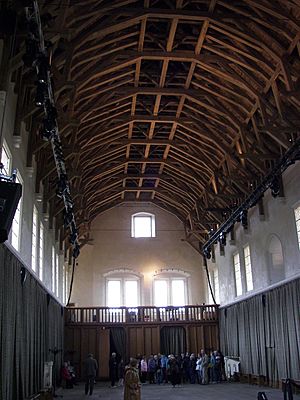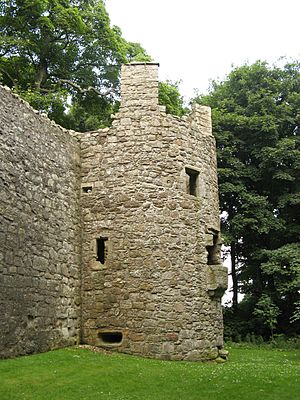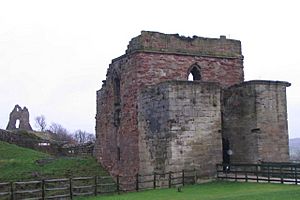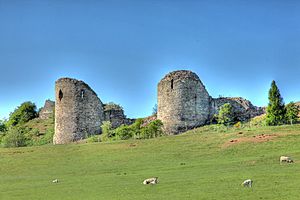Bastian Pagez facts for kids
Bastian Pagez was a talented French servant and musician who worked for Mary, Queen of Scots. He was known for creating fun and exciting entertainment at her royal court. One of his most famous events was for the baptism of Prince James at Stirling Castle in 1566. Later, when Mary was forced to leave Scotland and live in England, Bastian and his family stayed loyal and continued to serve her. Some historians from the 1800s thought his job was similar to a "Master of the Revels" in England, someone who organized all the royal parties and shows. In England, he was also Mary's personal helper and even designed patterns for her embroidery.
Contents
A Royal Party at Stirling Castle
Bastian first appears in Scottish records in 1565. Mary, Queen of Scots, and her husband, Henry Stewart, Lord Darnley, bought him a very fancy and expensive suit of clothes. This showed how much they liked him. A writer named James Melville of Halhill later wrote in his Memoirs that Bastian was in charge of a special show in the Great Hall of Stirling Castle. This show was part of the celebration for the baptism of Prince James, who would later become King James VI. However, the entertainment accidentally upset the English guests!
Mary and thirty special guests sat at a large round table, just like the legendary King Arthur's. The food for the dinner was brought into the hall on a moving table. Twelve men dressed as satyrs (mythical creatures, half-human, half-goat) pulled the table. They had long tails and carried lit torches. In their other hand, the satyrs carried whips to clear the way.
When the moving table reached the stage, the satyrs gave their torches to people nearby. Then, six servers dressed as nymphs (nature spirits) who had been sitting on the table, passed the food to the satyrs. The satyrs then brought the dishes to the round table on the stage. While this was happening, the nymphs and satyrs sang special Latin songs. These songs were written by George Buchanan and praised the food and the hosts. They were called the Rustic gods bringing gifts to James and his mother. Different parts of the song were sung by characters representing satyrs, nereids (sea nymphs), fauns (forest spirits), and naiads (water nymphs). They sang to the Queen and the Prince. The song ended with characters from the Orkney Islands.
Why the English Guests Were Upset
Even though the show was perfectly planned, the English guests got upset when the satyrs first wagged their tails. They thought it was a joke about an old saying that Englishmen had tails. This old story about English tails was first written down in the Middle Ages by historians like William of Malmesbury.
The legend came from a story that Saint Augustine cursed the men of Rochester to have rayfish tails. Later, they were called "muggles." Another writer, Polydore Vergil, wrote a newer version of the legend. He said the curse applied to people from Strood who had cut off the tail of Thomas Becket's horse. From this old tale, it became a common saying in Europe that all Englishmen secretly had tails.
James Melville, the writer, thought the English guests were too sensitive. He said they should have just pretended not to notice the joke. Some English guests, including Christopher Hatton, even turned their backs to the stage to avoid watching. Mary, Queen of Scots, and the English ambassador, the Earl of Bedford, had to work hard to calm things down. Melville said that Hatton told him he would have attacked Bastian for the insult. He felt it was done because Mary was showing more favor to the English than the French for once.
Details of the Royal Feast
The dinner with the satyrs serving food happened on December 19, 1566. This was two days after the Prince's baptism. An English report of the event said the moving table was pulled into the hall four times for four different courses of food. Each time, its decorations were changed. It broke during the fifth course!
Royal records show that Bastian was given a lot of "taffeta of cord" fabric in three colors. This was for seven "preparatives" for the baptism. "Preparatives" might mean the satyrs who were like "harbingers" or messengers for the feast. Or it could just mean the general preparations for the event. Another of Mary's servants, Servais de Condé, helped decorate the Great Hall.
On the day of the baptism, there were also fireworks. These were managed by John Chisholm and two gunners. There was also a show where "wildmen" attacked a pretend castle. Twenty-eight wildmen dressed in goatskins fought fifteen soldiers. These soldiers were dressed as landsknechts (German mercenaries), moors, and devils. They even had two cannons!
Prince James's father, Lord Darnley, was not getting along with Queen Mary at this time. He stayed hidden in the castle. The French ambassador, Monsieur du Croc, was told by King Charles IX not to speak to Darnley. On the day of the baptism, du Croc sent a message to Darnley. He said if Darnley came to his room, he would leave by another door.
Bastian's Wedding Party
Mary, Queen of Scots, went to Bastian's wedding dance on February 9, 1567. This was a "banquet and masque" (a fancy party with costumes and dancing). It happened the night before Lord Darnley was found dead at the Kirk o'Field lodging. On February 8, Mary gave Bastian black satin fabric for his wife's wedding dress.
George Buchanan, who called him Sebastian, said Mary left the wedding to meet Darnley. But she returned to Holyroodhouse to join the dance and follow the tradition of putting the bride to bed. It was said she wore men's clothes for the wedding party. She often liked to wear such clothes when dancing secretly with her husband or going out in masks at night. People who were involved in Darnley's death later mentioned the Queen's group passing by torchlight back to the wedding. This image has become a famous part of that night.
After Darnley's Death
After the Earl of Bothwell was accused of Darnley's murder, many of the Queen's French servants crossed into England on February 19, 1567. Only "Sebastian" was named by the Governor of Berwick, William Drury. He noted that all the French servants, except their Scottish escort, were wearing "Ilande wede" (Highland clothing).
On the same day, a secret message was put on the door of Edinburgh's Tolbooth. It accused Bothwell and demanded the arrest of Bastian and Joseph Rizzio, who was the brother of David Rizzio. At Bothwell's trial on April 12, 1567, a letter from Darnley's father, the Earl of Lennox, was presented. It named Bastian, Joseph, and Charles Bordeaux (the French gunner from the baptism fireworks) as suspects who should be arrested. However, Bothwell was found innocent, and nothing was done about Lennox's list.
Some older writers thought Bastian married one of the Queen's ladies, Margaret Carwood. But Bastian actually married Christily or Christine Hogg. Her name was recorded in the church register of Holyroodhouse and Canongate. The register entry, dated later that year, says the wedding took place in the Queen's House.
Margaret Carwood, one of the Queen's ladies-in-waiting, was married the day after Darnley's murder. It has been said that Margaret Carwood and Bastian went with the Queen when she rode to Dunbar Castle on March 12, 1566. This was after the murder of David Rizzio. A 17th-century story about the Queen's escape from Holyroodhouse after that murder says that Arthur Erskine of Blackgrange and Anthony Standen carried the Queen and Lord Darnley as pillion riders (riding behind them on the same horse) as they rode to Seton Palace. The Captain of the Queen's guard, John Stewart of Traquair, had one of the Queen's ladies behind him. Sebastian Broune rode alone. From this later story, it's not clear if this "Sebastian" was Bastian Pagez or another man with the same name.
Bastian's Journeys to London and Paris
On February 26, 1567, Bastian arrived in London with Mary's French money manager, Monsieur Dolu. They went to the Scottish ambassador, Robert Melville of Murdocairney. Bastian carried a letter from Mary to Queen Elizabeth. He gave it directly to Lord Burghley.
The Spanish ambassador in London identified Bastian as "the groom who married the night following the death of King." He reported that Mary's letter was full of sadness about her troubles. She also wished that no one in England would spread false rumors about her being involved in Darnley's death. Bastian then traveled with Dolu to Dieppe, France, in March 1567.
A "young French servant of the Scots queen" arrived in Paris on March 4. Historian John Hungerford Pollen identified him as Bastian. He brought a letter from Mary, written in Scots, for Vincenzo Laureo. Laureo was the Bishop of Mondovì and the Pope's representative for Scotland. The bishop found only one new detail in the letter: one of Darnley's ribs was broken. This detail was important to Mary because of the arguments about how Darnley died.
Neither of these letters carried by Dolu or Bastian still exist. But they probably carried the letter Mary wrote at Seton Palace on February 18 to the Archbishop of Glasgow in Paris. Bastian later returned to Scotland. He was arrested by the King's supporters the day after the Battle of Carberry Hill on June 16, 1567.
Bastian and His Family in England
Bastian and his family followed Mary into exile in England after she lost the Battle of Langside. Before he left Scotland, the new ruler, the Regent Moray, paid "Sebastian Padges Frenchman" £40 Scots. Mary had asked for Bastian to join her at Lochleven Castle in July 1567. The English ambassador Nicholas Throckmorton noted that she had asked the Scottish lords for "an embroiderer to draw forth such work as she would be occupied about."
Bastian and Christine Hogg were listed as part of Mary's household at Tutbury Castle in October 1569. They were also with her at Sheffield on May 3, 1571.
Mary wrote to John Lesley, Bishop of Ross, from Sheffield Castle in September. She said she had to let go of some servants, but Bastian was essential. Bastian's ideas for her needlework were her first comfort after her books. She had asked for him and his wife to join her from Scotland. They served her well and faithfully. However, they had children and no financial support, and his friends offered him better opportunities in France. She hoped the bishop could help him get a French job to give him enough money to stay with her. Mary wrote a similar letter on August 12, 1585, for another embroiderer named Pierre Oudry.
Mary's needlework might seem like just a hobby. But historian Michael Bath points out that one of her needlework emblems on a pillow was used in the trial of the Duke of Norfolk in 1571. This was after the Ridolfi plot, a plan that aimed to put Mary on the English throne. Bastian was later thought to have been involved in the plot to free Mary.
Secret Messages and Codes
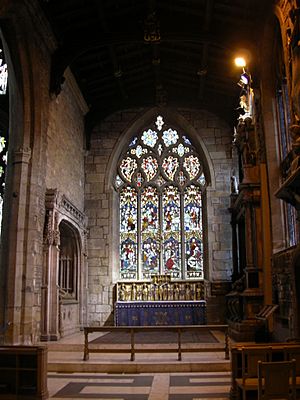
In November 1571, the Earl of Shrewsbury found out that Bastian had tried to send secret letters in code from Mary to the French ambassador. Bastian had been picking up the ambassador's letters from Nicolas, an English interpreter, in St Paul's Church in Sheffield. Shrewsbury asked Lord Burghley if he should do anything about Bastian. In 1574, Regent Morton discovered that Christine Hogg's mother in Edinburgh was involved in Mary's secret letters. She sent them through the Earl of Shrewsbury's Scottish schoolmaster.
Bastian's involvement in Mary's secret letters was noted again in 1575. In 1580, he sent a code key to one of his relatives. In December 1581, Mary asked for horses for four unarmed riders, including Bastian, to go on her coach trips. The other suggested riders were her secretaries Claude Nau and Gilbert Curll, and her household master Andrew Melville. They had also been mentioned with Bastian in connection with secret letters. In November 1584, Bastian traveled as far as Nottingham. He was with Claude Nau, who was going to London to meet Queen Elizabeth and the Scottish ambassador. On the way, they visited the yearly horse-fair at Lenton. Their freedom to travel like this raised some questions.
Bastian's Children in Captivity
For a time in 1578, Christine Hogg and her oldest daughter left Mary's household. The English official Walsingham stopped her from returning. By August 1587, Bastian and Christine had two daughters, Mary and Elizabeth, and two sons, David and Jacques. They also had five younger children whose names were not written down. David, the oldest son, left the Queen's household in May 1571. One child was born at Wingfield Manor in November 1569, around the time of the Northern rebellion.
Later, the Earl of Shrewsbury wrote that Mary, Queen of Scots, had planned to escape after the birth. She would dress as Christine's midwife. The midwife's part would have been played by Anne Somerset, the Countess of Northumberland. This was because they looked "something alike." The Northumberlands were staying at nearby Wentworth House. The Countess of Northumberland rode north to join the rebellion. On November 17, 1569, she was near Boroughbridge. The writer William Camden said that Leonard Dacre planned an escape from Wingfield at this time. Other, simpler escape plans involved Mary leaving through a window with a couple of servants.
When Mary, Queen of Scots, was to be moved to Tutbury Castle in November 1584, it was suggested that the children in her household should be sent away. Ralph Sadler wrote to Francis Walsingham, asking that the families not be separated. He said Christine was a necessary person whom the captive Queen could not do without. Bastian was housed in a separate building with Pierre Oudry, another embroiderer, and Marmaduke Dorrel, an English household officer. This building was inside the castle courtyard, separate from Mary's own rooms.
Mary thought her embroiderer's family would leave in September 1585. It was planned that Christine and her daughters, Mary and Elizabeth, would be removed from the household in January 1586. Bastian would likely be removed too. Even though he was useful to the Queen, he would not stay without his family. However, Bastian and his family remained with Mary at Chartley. This was probably because Christine was pregnant, and she had her child at Easter. The Queen's jailer, Amias Paulet, wrote to Francis Walsingham about being careful when hiring midwives.
Mary wrote on August 12, 1585, to the French ambassador in London, Michel de Castelnau. She asked him for a travel document for her "brodeur" (embroiderer) and his family. They were happy to return to France, where they would be better off than with her. She said two less skilled "garçon" (young male) embroiderers could serve her well enough. This letter referred to her other embroiderer called "Audrey," Pierre Oudrie, who had a wife and five children. Mary's jailer Amias Paulet was worried that Audrey's wife was a "woman of judgment and understanding" who might become a "dangerous messenger" for Mary. Six months later, she became mentally ill and had to be restrained. Pierre Oudrie had been an embroiderer for the queen in Scotland since 1562. Another embroiderer, Charles Pluvart, and Bastian and his family would stay with the Scottish queen until the end.
On March 20, 1586, at Chartley, Bastian Pagez and another servant, Jérôme Pasquier, witnessed a document. In it, Jacques Gervais, Mary's doctor, put his affairs in the hands of Jean de Champhuon. Champhuon was a relative of Mary's French secretary Claude Nau. He managed Mary, Queen of Scots' French properties.
Bastian and the Babington Plot
A letter from a plotter named Charles Paget gives a clue about Bastian's importance. Paget was part of the Babington Plot, a plan to free Mary (or to get her into trouble). His letter shows Bastian was close to the Queen but not a main secretary. Paget wrote to Mary on January 4, 1586, that he would try to get a Catholic priest into the house under a false name. The priest's innocent introduction letter would be given to Bastian or Christine. This way, if there was a problem, the secretaries would not be in danger. Paget's letter was caught, decoded, copied, and signed by important English officials.
When the English authorities decided to act on the plot on August 11, 1586, Mary was out riding. Bastian, her doctor Dominique Bourgoing, and others were with her. Armed soldiers surprised them and took them to nearby Tixall. When Mary was brought back to Chartley two weeks later, Bastian was offered the keys to Mary's room. But the Queen told him not to accept. She had an English officer open her things instead. She found her papers had been taken away. She then said two things could not be taken from her: her English blood and her Catholic religion. Paulet made a new list of her servants. He wrote: "If Bastian's wife is let go, it is likely that Bastian will want to go with his wife. This would not be a great loss because he is clever in his way and full of tricks to corrupt young men."
Fotheringhay and France
The Queen was moved to Fotheringay Castle. Bastian's daughter, Mary Pagez, appears on the list of Mary's servants at Fotheringhay after the Queen was executed in 1587. Her parents had been left behind. Paulet thought the servants dismissed at Chartley were "silly and simple souls," except for Bastian.
In a list of the Queen's belongings and gifts kept by her servants, Mary Pagez's father (Bastian) had 300 French crowns (money). He also had a "suit of savage attire." This might have been for his masque shows or the "Ilande wede" (Highland clothing) that Drury saw him wearing. Mary Pagez received a jewel with a sapphire from the Queen for her father. She also got another jewel with a green enameled bird. Christine was given a pair of bracelets and a ring.
After Mary, Queen of Scots' funeral at Peterborough Cathedral, the Pagez family was reunited. They were given travel documents to go to France. In her will of February 7, 1587, Queen Mary suggested that Mary Pagez should become a servant of the Duchess of Guise.
In 1601, a list of items at Hardwick Hall included "a picture of Bastean" in the wardrobe. This might have been a portrait of Bastian Pagez.


